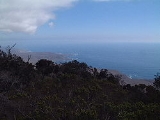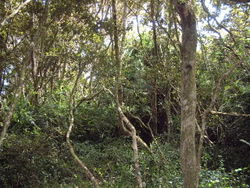
Bosque de Fray Jorge National Park
Encyclopedia
Bosque de Fray Jorge national park or Bosque Fray Jorge national park (Spanish Parque Nacional Bosque Fray Jorge) lies in the Limarí Province
, Coquimbo Region
, Chile
. It is a UNESCO
Biosphere reserve
.
 The national park
The national park
lies approximately 100 km south of La Serena on the Pacific Ocean
, as well as approximately 30 km to the west of Ovalle
. It lies close to the Atacama Desert
, in the Cordillera de Talinay
, which is part of the Chilean Coastal Range. On the south, the park is bordered by the Limarí River
.
The park covers an area of 100 km², but the forests cover only 4% of its surface. The national park is known for having the northernmost Valdivian temperate rain forests
. The coastal fog (Spanish: Camanchaca) hangs on the mountain-slopes and moistens subtropical vegetation, allowing the hydrophilic forests to survive despite of being surrounded of semiarid scrublands, with average annual rainfall of approximately 113 mm. The forest is a vestigial survival of the last glacial period
.
Typical plants of the national park include:
The park also includes a large number of smaller animals, as Degu
, Chinchilla
and foxes. Many different kinds of birds live in the park, such as the Chilean Tinamou
(Nothoprocta perdicaria) and the Long-tailed Meadowlark
(Sturnella loyca).
 The Bosque de Fray Jorge national park was created in 1941 and is administered by the Chilean forest authority CONAF. UNESCO incorporated the national park as a biosphere reservation in 1977.
The Bosque de Fray Jorge national park was created in 1941 and is administered by the Chilean forest authority CONAF. UNESCO incorporated the national park as a biosphere reservation in 1977.
Limarí Province
Limarí Province is one of three provinces of the Chilean region of Coquimbo Region . Its capital is the city of Ovalle-Geography and demography:...
, Coquimbo Region
Coquimbo Region
The IV Coquimbo Region is one of Chile's 15 first order administrative divisions. It is some 400 km north of the capital, Santiago.The capital and largest city is La Serena, other important cities include the seaport Coquimbo and the agricultural centre...
, Chile
Chile
Chile ,officially the Republic of Chile , is a country in South America occupying a long, narrow coastal strip between the Andes mountains to the east and the Pacific Ocean to the west. It borders Peru to the north, Bolivia to the northeast, Argentina to the east, and the Drake Passage in the far...
. It is a UNESCO
UNESCO
The United Nations Educational, Scientific and Cultural Organization is a specialized agency of the United Nations...
Biosphere reserve
Biosphere reserve
The Man and the Biosphere Programme of UNESCO was established in 1971 to promote interdisciplinary approaches to management, research and education in ecosystem conservation and sustainable use of natural resources.-Development:...
.
Geography

National park
A national park is a reserve of natural, semi-natural, or developed land that a sovereign state declares or owns. Although individual nations designate their own national parks differently A national park is a reserve of natural, semi-natural, or developed land that a sovereign state declares or...
lies approximately 100 km south of La Serena on the Pacific Ocean
Pacific Ocean
The Pacific Ocean is the largest of the Earth's oceanic divisions. It extends from the Arctic in the north to the Southern Ocean in the south, bounded by Asia and Australia in the west, and the Americas in the east.At 165.2 million square kilometres in area, this largest division of the World...
, as well as approximately 30 km to the west of Ovalle
Ovalle, Chile
Ovalle is a city in the Coquimbo Region of Chile, founded in 1831 as a settlement of more than 113,000 people. The name Ovalle was chosen to honor to Chile's vice-president José Tomás Ovalle...
. It lies close to the Atacama Desert
Atacama Desert
The Atacama Desert is a plateau in South America, covering a strip of land on the Pacific coast, west of the Andes mountains. It is, according to NASA, National Geographic and many other publications, the driest desert in the world...
, in the Cordillera de Talinay
Cordillera de Talinay
The Cordillera de Talinay is a mountain range situated in the Coquimbo Region of Chile. The range consists of a series of hills and foothills spreading more than 40 km in a north-south direction from the coast, but which descend to meet the Limari river as it crosses Chile's Intermediate Depression...
, which is part of the Chilean Coastal Range. On the south, the park is bordered by the Limarí River
Limarí River
Limarí River is a river of Chile located in the Coquimbo Region. The river is formed at the confluence of the Hurtado and Grande rivers, about 4 km east of the city of Ovalle. The lower course of the river borders the southern portion of Bosque de Fray Jorge National Park...
.
The park covers an area of 100 km², but the forests cover only 4% of its surface. The national park is known for having the northernmost Valdivian temperate rain forests
Valdivian temperate rain forests
The Valdivian temperate rain forests are a temperate broadleaf and mixed-forest ecoregion located on the west coast of southern South America, lying mostly in Chile and extending into a small part of Argentina. It is part of the Neotropic ecozone. The forests are named after the city of Valdivia...
. The coastal fog (Spanish: Camanchaca) hangs on the mountain-slopes and moistens subtropical vegetation, allowing the hydrophilic forests to survive despite of being surrounded of semiarid scrublands, with average annual rainfall of approximately 113 mm. The forest is a vestigial survival of the last glacial period
Ice age
An ice age or, more precisely, glacial age, is a generic geological period of long-term reduction in the temperature of the Earth's surface and atmosphere, resulting in the presence or expansion of continental ice sheets, polar ice sheets and alpine glaciers...
.
Typical plants of the national park include:
- Peruvian pepper Schinus latifolius
- EpiphyteEpiphyteAn epiphyte is a plant that grows upon another plant non-parasitically or sometimes upon some other object , derives its moisture and nutrients from the air and rain and sometimes from debris accumulating around it, and is found in the temperate zone and in the...
- Azara celastrina
- Lithraea venenosa
- Porlieria chilensis
- Olivillo (Aextoxicon punctatumAextoxicon punctatumAextoxicon punctatum, the sole species of genus Aextoxicon and family Aextoxicaceae, is a tree native to southern Chile and Argentina....
) - Sarmienta scandens
- Griselinia scandens
The park also includes a large number of smaller animals, as Degu
Degu
The degu is a small caviomorph rodent that is endemic to central Chile.It is sometimes referred to as the brush-tailed rat, and is also called the common degu, to distinguish it from the other members of the genus Octodon. Other members are also called degus, but they are distinguished by...
, Chinchilla
Chinchilla
Chinchillas are crepuscular rodents, slightly larger and more robust than ground squirrels, and are native to the Andes mountains in South America. Along with their relatives, viscachas, they make up the family Chinchillidae....
and foxes. Many different kinds of birds live in the park, such as the Chilean Tinamou
Chilean Tinamou
The Chilean Tinamou, Nothoprocta perdicaria, is a type of tinamou commonly found in high altitude shrubland in subtropical regions of central Chile.-Etymology:...
(Nothoprocta perdicaria) and the Long-tailed Meadowlark
Long-tailed Meadowlark
The Long-tailed Meadowlark is a passerine bird of southern South America and the Falkland Islands, belonging to the meadowlark genus Sturnella in the icterid family....
(Sturnella loyca).
History


